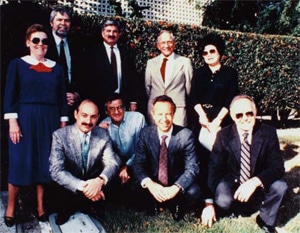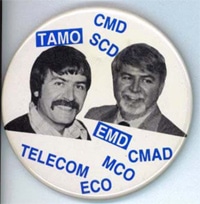Updated 5/26/11
Thoughts on Intel and Retirement
by Tom Innes
April, 2008

I don’t really remember when I started thinking about retirement, but for sake of the story, I will blame Ted Jenkins! I got a telephone call late one afternoon in mid-1993. It was Ted calling to tell me he had just figured out that I was the first person to spend more than half his/her life at Intel. Only Ted would be aware enough, and think it important enough, to pick up the phone! Of course, Ted would be the second person to achieve that illustrious threshold a couple months later! I also remember another incident in the spring of 1995; I had finished a two-week stint at the Israel Design Center and was on my way home. About 20 Arizona Development Center design engineers had relocated to IDC and were working on the first SIMD version of the Pentium Processor. I would spend roughly 2 weeks every quarter with them and the IDC team.
I always enjoyed these trips since it gave me a chance to renew my acquaintance with a team that I had helped build 20 years earlier and with the city of Haifa which had been our home for 18 months. This time, I remember as I was clearing passport control, that the young lady questioning me informed me that my passport was about to expire. I didn’t renew it. So, subconsciously I must have had the R word lurking in my head;I guess it took the “rule of 75” to put me over the edge! I didn’t want to stop working, but I did want to get control of my time and travel!
My last day was December 31, 1998 – 30 years and 22 days, 16 organizations, 18 different bosses give or take, and three different 2-in-a-box stints with, would you believe, Dean Toombs, Ken Fine and Jean-Claude Cornet!
About 6 months after I retired, I got an email from a colleague who was thinking about retirement. He wanted to know what I had learned. About all I had learned at that point was that retirement was a lot like workwithout the great admin support – (THANK YOU Joanne Humiston, Ernie McGhee and Nancy Sanuik for keeping me in control for 18 years in Chandler!). I also knew that Karen didn’t want me hanging around the house all day! Fast forward 9 years and a bit – Sharon Bernier asked me if I would write a column for the Intel Retiree News Letter and, without giving it enough thought I said, “Sure, I’d be happy to”. As the deadline approached and reality set in, I began to think it wasn’t such a great idea after all. Sharon’s email had suggested that my perspective on the upcoming 40th anniversary would be a good theme. Being gone for almost 10 years leaves out a lot of the history, so I was worried that anything I had to say would be, at best, incomplete and perhaps totally irrelevant.

Shortly after Sharon’s email, I was back in northeastern Pennsylvania visiting my Mom, who turned 99 early this year. Since she moved into a “personal care home” a couple years ago, my brothers and I have been slowly sorting through all the desk drawers and boxes of stuff that Mom had saved over the years – the only “ records retention policy” as far as Mom is concerned is to save everything! Sorting through 4 generations worth of photographs, newspaper clippings, letters, cards etc, I came across several newspaper clippings about Intel. These were all from the early ‘70s – well before Intel was a household name. Reading them brought back a flood of my own memories and suddenly I felt like I had a place to start and a theme for this article.
Some of the articles were interview pieces featuring one or more of Bob Noyce, Gordon Moore and Andy Grove; others were business articles about the volatile, risky new “semiconductor” business. What came back to mewas the palpable sense of excitement that existed at that time and place. For anyone born in the past thirty years, “computer chips” have always been a given, a commodity item, but the period from roughly 1965 to 1972 set the foundation for all that has happened since. It is a period which hasn’t been given its due by the technology historians, but it was a period of incredible technical inventiveness in process technology,device and circuit design and manufacturing/cost engineering.
The term LSI had been coined some time in 1966 or 1967. I remember Bob Noyce’s key note address at the ’67(or was it ‘68?) ISSCC in Philadelphia; with tongue firmly in cheek, Bob compared LSI definitions to the plethora of different sizes of California olives! I remember the famous Fairchild ad series that ran on the inside front cover of Electronic News announcing one new product every week for a year! TI’s Series 54 TTLcircuits were just starting to become a standard, supplanting the earlier DTL logic from Fairchild. I was working at Sylvania Semiconductor Division in Woburn MA on competing TTL circuits. The production state of the art was a Dual J-K Flip-Flop – approximately 50 transistors on a gold-doped bipolar process manufactured on 1.5” wafers. The industry was alive with amazing efforts and a few customers wanted to have their own families of logic devices – Honeywell issued an RFQ for something they named a Synchronous, Raceless Flip-Flop (we called it the Simply Ridiculous F-F1). NCR tried to standardize their logic design around the 3-input NOR gate – every element in their family was made up of a combination of these simple gates. Companies on both coasts plus TI and Motorola were driving to capitalize on integrated circuit technologies. Mostof the ideas fell by the wayside as did most of the companies. But, with Gordon Moore’s 1965 observation/prediction as a starting condition, with the introduction of the first generation LSI circuits in 1968 and 1969, and the development, introduction and high volume manufacturing of three major new product concepts – the DRAM, the EPROM and the micro-processor in 1970,
1 Think of it as “whack-a-mole” for spurious clock/data signals. At Intel I learned that I wasn’t the only guy in the industry working on this kluge A pin that some of the Chandler folks put together for me as I was on to a new assignment – (1992 or 1993)
1971 and 1972 respectively, Intel not only developed a successful business, but laid the course for the next three decades of semi-conductor history.
Intel was started with a mission to exploit the advances in integrated circuit technologies to build a business in semi-conductor memories. To that end there were three major technologies and associated circuit designs underway in late 1968. All three required development breakthroughs and two of the three resulted in product introductions and volume production in 1969. The technologies and the results are described in some detail in Intel’s 25 year publication. I was fortunate enough to be involved with two of the three developments –
- Schottky-Bipolar – early devices were unstable (we dubbed them “shaky schottkys”) but one specific configuration proved more reliable and the first Intel product was produced using this technology – the i3101 64 bit scratch-pad memory, designed by Dick Bohn, was introduced in April 1969. The Schottky processing was worked out by Ted Jenkins, and I did much of the initial device characterization. Similar technology, with minimal on-going process development, was used for about ten years to build bipolar PROMS and special interface devices as well as a number of customer-specific chips.
- Silicon gate PMOS – the processing proved more difficult due to cracking of the metal interconnect. The key technical breakthrough was Gordon Moore’s idea of re-flowing the glass passivation layer to relieve the step edges to provide a more even surface for the metal interconnect. The first product – the i1101 256 bit memory, developed by Les Vadasz and Joel Karp was introduced later in 1969. The Si-gate process and its NMOS successors became the workhorse technologies for all future high volume DRAM, SRAM , EPROM and Microprocessor products
- Flip-chip Multi-chip module – this third approach, which was initially thought to be necessary to achieve the memory density to rival core systems was abandoned after only a few completed modules were built. Somewhere in storage is a box with my name on it that has – as far as I know – the only remaining samples of the i2001 1024 bit memory. This was made up of four 1101 chips with 1mil thick aluminum bumps flip-chipped onto a 900mil x 300mil silicon substrate all packaged in a 24 lead dual-in line ceramic package. A small bipolar decoder/driver sense amp device (the i2201) allowed configurations off 1024 x 1, 512 x 2or 256 x4. It was gorgeous! The problem was it dissipated 2.2 watts and had an over all yield of <1% by the time it got through the bumping process.
Interestingly at this same time, in the same lab space Joel Karp and Bill Regitz(then working for Honeywell, but soon to join Intel) were working on a new type of memory device that made use of the parasitic capacitance inherent in the PMOS device as a storage element. This work led to the development of the 1103 Dynamic Random Access Memory which was introduced late in 1970 and by the end of 1971 would be the largest selling semi-conductor device in the industry! This product spawned an entire industry segment, several new start-ups and signaled the end of core memory.
Technologies and products weren’t the only the things being developed at this time. Whether we realized it or not, an operating culture was being formed, led from the top. The behaviors and attitudes that we would only much later2 come to identify as “Intel Culture” were crystallized in those early years. I don’t mean the formalized 6 Intel Values on the badges nor do I mean the levels of bureaucracy that came to be in placeas a substitute for confidence and trust in individual or group behavior. Some of the latter was inevitable with tremendous growth and geographic dispersion that occurred in the late 70s and 80s. What I am talking about are the expectations that were set from the beginning –
- expectations of accountability and delivery to ones commitments;
- the discipline of objectively measuring, reporting and reviewing progress as a means of tracking and achieving results and,
- the behavior which may be unique to Intel, the practice of “disagree and commit”. When I have described the latter behavior to people outside Intel they frequently shake their heads in disbelief. The notion that one can argue vigorously for an opposing viewpoint, but once the decision is made, support that decision with the same vigor is foreign to many organizations.
Over the years a degree of formalization took place to extend these practices to the new locations, new cultures and the thousands of new employees. You could walk into any Intel facility anywhere in the world and see iMBOs posted, one-on-ones being held and MOMRs in process. This last practice was an outgrowth of the practice established from the beginning with the weekly technical reviews – an all hands meeting in the one conference room next to Gordon’s office. Later as the organization grew, these would transition to the more formalized practice we called MOMRs – Monthly Operations Management Reviews.
The best description of this activity that I ever heard was Ken Fine’s formula for a successful MOMR – “Everything is not all right; I own the problem and here is the plan!” These behaviors and practices have become second nature and I suspect an entire generation or two of off-spring have been raised with some exposure to “key results” and “one-on-ones”.
So, now, nine years and a bit later, what HAVE I learned about retirement? Well it’s not only a lot like work, it IS work. It requires the same set of disciplines and even better time management (again – no great admin to keep you from being distracted!). I learned that I really miss the excitement and challenge of new product development and high volume production. I learned that the values work in two small companies that I helped start. On the surface these two companies couldn’t have been more different. One is a fabless semiconductor company; the other developed and manufactured adult incontinence products – that’s right folks – diapers – hey it’s a dirty job etc etc. They also work in the non-profit world; the Arizona Science Center has benefited from these same values and I am extremely proud of my association and Intel’s long time and continuing support of this wonderful Arizona treasure.
2 If memory serves – and increasingly I find it doesn’t – I believe the first person to articulate that there was such a thing as an “Intel Culture” was not an Intel employee, but the management consultant – Bill Daniels. Somebody correct me if this isn’t right.
I have learned that my 18 month old grandson is an amazing person and he is a constant reminder that his father, Rob, and mother, Jennifer and grandmother, Karen are also amazing individuals in my life!
I have also learned that I hate golf; that the older I get the more I love the technologies I missed in my youth – automobiles and audio particularly – and that I will probably always use the pronoun “we” when talking to someone about Intel.


